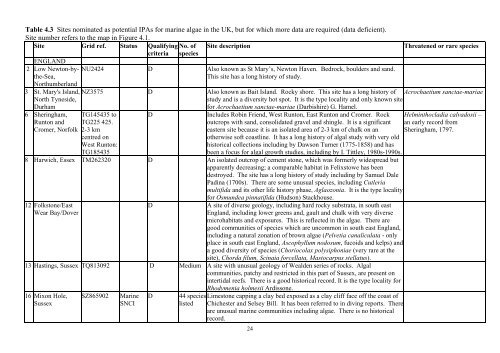Important Plant Areas for algae - Natural History Museum
Important Plant Areas for algae - Natural History Museum
Important Plant Areas for algae - Natural History Museum
You also want an ePaper? Increase the reach of your titles
YUMPU automatically turns print PDFs into web optimized ePapers that Google loves.
Table 4.3 Sites nominated as potential IPAs <strong>for</strong> marine <strong>algae</strong> in the UK, but <strong>for</strong> which more data are required (data deficient).<br />
Site number refers to the map in Figure 4.1.<br />
Site Grid ref. Status Qualifying No. of Site description<br />
criteria species<br />
ENGLAND<br />
2 Low Newton-bythe-Sea,<br />
NU2424 D Also known as St Mary’s, Newton Haven. Bedrock, boulders and sand.<br />
This site has a long history of study.<br />
Northumberland<br />
3 St. Mary's Island, NZ3575 D Also known as Bait Island. Rocky shore. This site has a long history of<br />
North Tyneside,<br />
study and is a diversity hot spot. It is the type locality and only known site<br />
Durham<br />
6 Sheringham,<br />
Runton and<br />
Cromer, Norfolk<br />
TG145435 to<br />
TG225 425.<br />
2-3 km<br />
centred on<br />
West Runton:<br />
TG185435<br />
<strong>for</strong> Acrochaetium sanctae-mariae (Darbishire) G. Hamel.<br />
D Includes Robin Friend, West Runton, East Runton and Cromer. Rock<br />
outcrops with sand, consolidated gravel and shingle. It is a significant<br />
eastern site because it is an isolated area of 2-3 km of chalk on an<br />
otherwise soft coastline. It has a long history of algal study with very old<br />
historical collections including by Dawson Turner (1775-1858) and has<br />
been a focus <strong>for</strong> algal growth studies, including by I. Tittley, 1980s-1990s.<br />
8 Harwich, Essex TM262320 D An isolated outcrop of cement stone, which was <strong>for</strong>merly widespread but<br />
apparently decreasing; a comparable habitat in Felixstowe has been<br />
destroyed. The site has a long history of study including by Samuel Dale<br />
Padina (1700s). There are some unusual species, including Cutleria<br />
multifida and its other life history phase, Aglaozonia. It is the type locality<br />
<strong>for</strong> Osmundea pinnatifida (Hudson) Stackhouse.<br />
12 Folkstone/East<br />
Wear Bay/Dover<br />
D A site of diverse geology, including hard rocky substrata, in south east<br />
England, including lower greens and, gault and chalk with very diverse<br />
microhabitats and exposures. This is reflected in the <strong>algae</strong>. There are<br />
good communities of species which are uncommon in south east England,<br />
including a natural zonation of brown <strong>algae</strong> (Pelvetia canaliculata - only<br />
place in south east England, Ascophyllum nodosum, fucoids and kelps) and<br />
a good diversity of species (Choriocolax polysiphoniae (very rare at the<br />
site), Chorda filum, Scinaia <strong>for</strong>cellata, Mastocarpus stellatus).<br />
13 Hastings, Sussex TQ813092 D Medium A site with unusual geology of Wealden series of rocks. Algal<br />
communities, patchy and restricted in this part of Sussex, are present on<br />
intertidal reefs. There is a good historical record. It is the type locality <strong>for</strong><br />
Rhodymenia holmesii Ardissone.<br />
16 Mixon Hole,<br />
Sussex<br />
SZ865902<br />
Marine<br />
SNCI<br />
D<br />
44 species<br />
listed<br />
Limestone capping a clay bed exposed as a clay cliff face off the coast of<br />
Chichester and Selsey Bill. It has been referred to in diving reports. There<br />
are unusual marine communities including <strong>algae</strong>. There is no historical<br />
record.<br />
24<br />
Threatened or rare species<br />
Acrochaetium sanctae-mariae<br />
Helminthocladia calvadosii –<br />
an early record from<br />
Sheringham, 1797.

















